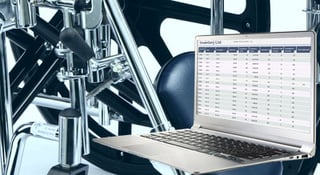
All accrediting bodies, HQAA included, have standards that require an effective equipment tracking system in place at every organization surveyed. Tracking systems are essentially a tool to help you keep track of where all your equipment and supplies are at any given time. The purpose of these tracking systems is for not only good overall inventory control and management, but also to facilitate a recall in the event a manufacturer or the FDA institutes a recall.
The simple rule of thumb regarding “what” equipment and supplies needs to be tracked is this: if it has a serial or lot number, it should be tracked. Any item with a serial number—be it a ventilator, an oxygen producing device, or a piece of DME such as a hospital bed headboard or a wheelchair’s elevating leg rest—should be tracked. Organizations can choose how they track equipment and should develop policy and procedure to address how equipment and supplies are tracked.
Tracking systems include paper systems such as logbooks, note card inventory systems, and tickler files. They also include electronic systems such as inventory control software, typically interfaced with your company’s billing software. Some electronic systems are simply spreadsheets, such as Excel files with a log of where equipment/devices are located. These systems—both the paper and electronic systems—are only as good as the person filling out the paperwork or the person inputting data into a computer program. A simple system that works well and is efficient is better than a more complicated system that doesn’t work or becomes cumbersome and inefficient. The key here is to quickly be able to locate equipment no matter where it is or how long it’s been out.
While it’s important to be able to locate and recall ANY equipment with a serial number, obviously some equipment categories require a higher level of tracking and a more sophisticated recall process. With diabetic testing supplies, some companies implement a recall and tracking process whereby they list all their customers and any lot numbers that come into their inventory by date. An acceptable recall process might be something as simple as being able to cull out by timeframe the customers that received testing supplies during some given time period. Letters and/or emails to customers asking them to check their supplies and bring in any recalled lot numbers for exchange might be adequate. That system would NOT work for ventilators or other life sustaining DMEPOS. For this life sustaining equipment, actual serial number tracking in a system whereby your company can pinpoint the exact location of a piece of equipment is important, necessary, and required.
Expect the surveyor to “test” the system. He or she will typically review your policy and procedure and interview staff throughout the survey process regarding your tracking and recall procedure. All staff that works with equipment including warehouse and maintenance employees, delivery technicians, and clinicians performing deliveries, should be aware of the procedure and be able to describe it to the surveyor. The surveyor will typically gather some serial and/or lot numbers throughout the course of the survey. Some may come from copying numbers down from equipment he or she sees during a tour of the warehouse and also during home visits. They also may gather numbers from charts they review. Companies have described their procedure and how they keep track, and “the proof is in the pudding” so to speak. The surveyor will present these serial numbers and ask the company to validate that their system works by finding the location of the equipment.
HQAA standards ICS 5 — “PRODUCT/ITEM RECALL” and MM 3 – “EQUIPMENT/DEVICE INVENTORY TRACKING AND MONITORING FUNCTIONS” are the two standards that contain the specific language relating to your organization’s tracking procedures. Be sure to familiarize yourself with those standards, and be prepared to describe the processes your company uses to locate, track, and recall equipment and supplies.
Finally, the best “test” to ensure you are compliant with these standards is to perform random mock recalls yourself. Do exactly what the surveyor will do and gather some serial and/or lot numbers randomly. Be sure to find serial numbers on invoices in the patient charts, on equipment in the warehouse, and from equipment in various patient homes. Test the system and see if your procedure is working properly. Test the system on a regular basis to make sure the system is being updated as deliveries and returns occur and change the inventory on a daily basis.
A good tracking system is good business. Inventory control and management are much easier if your company has a good understanding of what equipment is out on patients and where it’s located.


